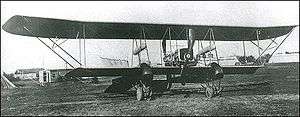Sikorsky S-19
| S-19 | |
|---|---|
 | |
| Role | Experimental prototype |
| National origin | Russian |
| First flight | 1916 |
| Number built | 1 |
The Sikorsky S-19 was a Russian twin engine experimental prototype aircraft built late in 1916 by the Russian Baltic Railroad Car Works while Igor Sikorsky was chief engineer of the aircraft manufacturing division.
Design and development
The S-19 was a two bay sesquiplane powered by two 150 horsepower (112 kilowatts) Sunbeam Crusader water-cooled V-8 engines installed in push-pull configuration. Arranged as a twin-boom aircraft, it had a large rudder located in the center of the empenage. Two crewmembers occupied cockpits in the foreword most section of the booms in front of the lower wing and served as pilot and machine gunner.[1][2][3]
Flight testing revealed sluggish performance and the aircraft was scrapped after a minor crash.[4]
See also
References
- ↑ "The Russian Years". www.sikorskyarchives.com. Sikorsky Archives. 7 May 2013. Retrieved 19 March 2017.
- ↑ "Igor Sikorsky". aerofiles.com. Aerofiles. Retrieved 19 March 2017.
- ↑ "Sikorsky S-19". all-aero.com. All-aero. Retrieved 19 March 2017.
- ↑ "S-19 'Dvukhvostka'". ram-home.com. Russian Aviation Museum. 8 September 1997. Retrieved 19 March 2017.
This article is issued from
Wikipedia.
The text is licensed under Creative Commons - Attribution - Sharealike.
Additional terms may apply for the media files.